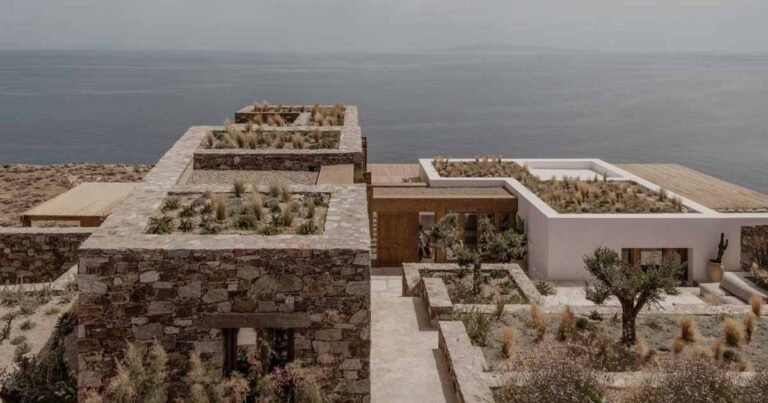arched stone wall rises from the bottom to embrace ‘chapel of the final farewell’ in poland
a last farewell venue in poland
architects jakub turbasa and bartłomiej pyrzyk were commissioned to design a new chapel at the old cemetery in rychwałd, poland. dubbed the ‘chapel of the last farewell’, the project was born out of the local community’s desire to create a suitable last venue as a means of continuation of the age-old, slowly passing, tradition of bidding farewell to the deceased at home.
the project was recognized as the winner of 2021 year edition of the ‘salon architektury’ competition organized by malopolska regional chamber of architects of the republic of poland. it was also nominated as the project of 2021 year edition of the ‘award of the year 2021’ organized by the association of polish architects.

to return to one’s roots
located right next to an old cemetery, the chapel emerges as an expansion to the pre-existing baroque complex with the minor basilica of st. nicholas. this new structure consists of a praying space and accompanying rooms, including a place with cold storage for the bodies, technical rooms, a utility room, public toilets, etc.
the simplicity of the architecture derives from the archetypal, traditional forms of chapels with gable roofs, which also appear in the region. the design turns towards the origins of building sacral objects, while constituting their contemporary reinterpretation, which is expressed by large triangular glazing, ‘hanging’ walls in the interior, synthesis of the details, etc. the chapel’s architecture is characterized by the selection of natural materials such as wood or stone. the contact with noble and natural matter opens a person, through their senses (touch, smell, acoustics, etc.), to the multidimensionality of space as well as to a more profound cognition and experience.
functional and symbolic architecture
the structure consists of two parts that adequately express the function related to the spaces of sacrum and profanum. the first one refers to the space of prayer – the chapel, which clearly communicates its function through its distinctive form. the second one, covered in greenery, rises from the ground along a delicate arch, encompassing the aforementioned accompanying rooms. meanwhile, it forms a natural boundary between the cemetery zone with the chapel and the parking, facilities, as well as the caravan zone. the visual distinction between these zones is also emphasized by the material on the facades – polished (chapel) and raw (accompanying parts) sandstone.
due to the function and the character of the building, the design concept echoes the memory of the so-called ‘paschal path’ —the last moments of christ’s life— from the passion, through death, to resurrection, which are symbolically expressed in architecture.
Passion, Isolation, Solitude, and death
during the first stage, where individuals cross the boundary of the consecrated land (the boundary of the cemetery) and head towards the main entrance to the chapel, the person experiences a gradual tranquillity and concentration. thanks to the greenstone walls growing out of the ground (and hiding the accompanying rooms underneath), one isolates themselves more and more from the outside world, reaching the reality of the profanum. after crossing the threshold of the chapel, a person finds themselves in a vestibule filled with darkness. reinforced concrete walls and the ceiling are black, which aims to emphasize the impression of immensity, infinity, and ‘immateriality’ of a place where all contours are lost. the severity of this place expresses the stage of the aforementioned passion — loneliness, suffering, jesus’ prayer in the olive garden.
at the end of the chapel’s perspective and also at eye level, you can see a filigree cross that expresses the next stage: death. the wooden, historic sculpture of christ was obtained from a desacralized church in belgium. then, through the zone of darkness, visitors enter the actual zone of prayer, taking shape as a bright space that symbolizes the hope of the christian vocation (according to the christian faith, life does not end with death). in the place where people gather around the body of the deceased, their attention is not focused on the reality of death, but on the perspective of eternal life. that is why the architecture of the interior naturally guides the gaze upwards and towards the light.






